Special Interview_Onomatopoeia allows looking back to the origin of language and forward to interdisciplinary collaborations
<Interviewee>
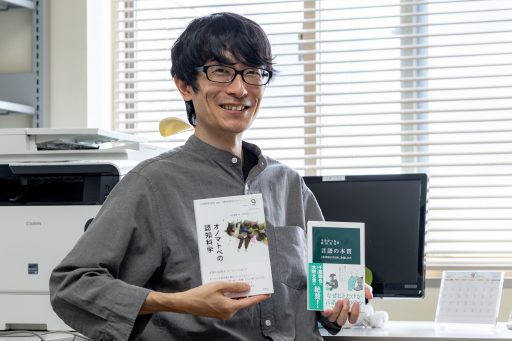
Kimi AKITA (Ph.D.)
Associate Professor, Graduate School of Humanities, Nagoya University
—
Dr. Akita is the author of Onomatope no Ninchi Kagaku (“Cognitive Science of Onomatopoeia”) and co-author of Gengo no Honshitsu: Kotoba wa Doo Umare Shinka Shita ka (“The Nature of Language: How Language Was Born and Evolved”). The latter is a bestseller with a circulation of over 200,000 copies. While focusing on onomatopoeia, Dr. Akita also conducts cross-disciplinary research.
—
● Encounter with the study of onomatopoeia and the development of the field
Dr. Akita used to study English linguistics, with special attention to expressions of emotions. “Worried,” “excited,” and “surprised” may be expressed in Japanese with the onomatopoeia “kuyo-kuyo,” “waku-waku,” and “bikkuri,” respectively. Through a close examination of the two languages, he noticed that Japanese has many more types of onomatopoeia than English. Onomatopoeia (termed “ideophones” in linguistics) attracted his interest, but the field is often viewed as peripheral in the realm of linguistics. At first, he thought he would work on onomatopoeia only for his master’s thesis. Before he knew it, however, he came to devote himself to the field for 20 years.
“What motivates me to keep working on onomatopoeia,” Dr. Akita remarks, “is their seemingly chaotic behavior. They are impressionistic and are not apparently linguistic, but on a closer look, they follow certain patterns.”
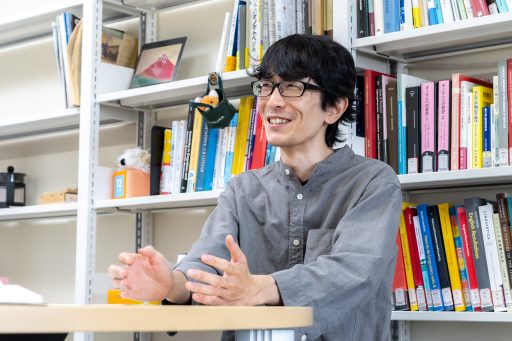
We use onomatopoeia every day but know very little about them. Examining them from a linguistic perspective allows finding numerous hidden regularities and commonalities with other languages, which fascinates Dr. Akita.
Onomatopoeia, a category of words that express sounds, states, and actions, is particularly familiar to Japanese speakers. For example, “sara-sara,” “gotsu-gotsu,” and “sorori-sorori” describe a rustling sound, a hard, rough surface, and slow, quiet steps, respectively. It is not easy to define onomatopoeia, but experts consider them to be “iconic” words, which here mean symbols that directly reflect sensory information. “(^_^)” is a Japanese icon that visually depicts the characteristics of a smiley face. Similarly, onomatopoeic words such as “meow” and “bow-wow” can be considered as iconic words that auditorily imitate the sounds of cats and dogs.
Although iconic, onomatopoeia are not primitive or immature. They follow systematic patterns. For example, “sara-sara” may be an adverb as in “A brook is running sara-sara (smoothly),” or an adjective as in “Your skin is sara-sara (smooth).” Intriguingly, the accent pattern differs between the two cases. When the word is used as an adverb, its pitch pattern is high-low-low-low. When it is used as an adjective, its pitch pattern is low-high-high-high. The same holds true for other adverbial and adjectival onomatopoeia.
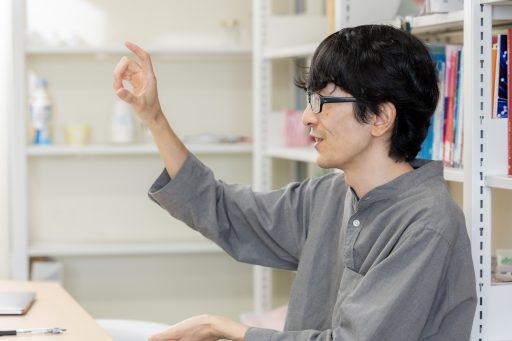
Onomatopoeia have attracted particular attention since the beginning of the 21st century. Look at the two figures drawn below. Now, if you had to name one of them “bouba” and the other “kiki,” which one would be “bouba” and which would be “kiki”?

There are linguistic sounds that match spiky figures and those that go well with rounded figures. Please note that the figures shown above were drawn by the author of this article with reference to Fig. 7 in the paper published by V. S. Ramachandran and E. M. Hubbard in 2001.(1)
Interestingly, most people pick “kiki” for the left figure and “bouba” for the right figure in a wide range of languages. Visual impressions and verbal sounds are two different types of sensory information, but they are interconnected. This phenomenon is called the “bouba/kiki effect,” which was named as such by V. S. Ramachandran and E. M. Hubbard in a paper published in 2001.(1) When humans started using words, perhaps they might have systematized them into language through the accumulation of such phenomena. It is difficult to prove this hypothesis, and there are many competing theories on the matter. Nevertheless, the paper captured the spotlight at that time as a clue to the origin of language.
Dr. Akita thinks that the bouba/kiki effect is closely related to onomatopoeia, in that it concerns the iconicity of visual and auditory information just as onomatopoeia do. As a natural consequence, he has been investigating the relationship between onomatopoeia and the origin of language. The relationship is difficult to prove because you cannot trace back the changes in language over a hundred thousand years. Dr. Akita himself confesses that it is somewhat scary to work on this huge issue. Nevertheless, he boldly explored this topic, which led to the book Gengo no Honshitsu: Kotoba wa Doo Umare Shinka Shita ka,(2) which he co-authored with Dr. Mutsumi Imai. While quoting from the book, the next section will give some examples of how language begins with highly iconic words such as onomatopoeia and then gradually loses iconicity as it becomes systematized.
(1) Ramachandran, V. S. & Hubbard, E. M. (2001). Synesthesia: a window into perception, thought, and language. Journal of Consciousness Studies, 8: 3-34.
(2) Gengo no Honshitsu: Kotoba wa Doo Umare Shinka Shita ka
Co-authored by Mutsumi Imai and Kimi Akita, Chuko Shinsho, First edition published on May 24, 2023
● How are highly iconic words systematized?
“In fact, surprisingly many ‘ordinary words’ that we currently do not consider to be onomatopoeic were once onomatopoeic words” (p. 141). The language we use today did not suddenly come into existence one day as a complete system. For example, the onomatopoeic words “tat-tat” and “fuu” are said to be the origins of certain ordinary words. According to Dr. Nakami Yamaguchi, a leading researcher on the history of Japanese onomatopoeia, “tat-tat” and “fuu” were joined with “ku,” an archaic Japanese suffix making verbs, changing into “tataku” (hit) and “fuku” (blow), respectively. The onomatopoeia “kara” and “ugui,” which transcribe animal sounds, were joined with “su,” a suffix that indicates a bird, becoming “karasu” (crow) and “uguisu” (Japanese bush warbler), respectively. Through the addition of affixes or through conjugation, many onomatopoeic words were changed into ordinary words, allowing them to be used as nouns and verbs.
Nicaraguan Sign Language is a famous example of the way highly iconic words are systematized over generations. It attracts the attention of researchers as an example of a language whose changes were observed almost in real time in the modern age; they took place within the last 50 years.
Nicaragua, a Central American country, used to have neither an education system for deaf children nor a standard sign language. Sometime between 1970 and 1980, an environment was developed for such children to study at school. The first generation of these children created a sign language as a means of communication, which was passed on to the next generation. One of the changes that occurred during this process was “the division of gesture into elements, and the recombination of these divided elements” (p. 147). For example, when signing the concept “rolling down,” first-generation children used a highly iconic gesture that precisely portrayed the action visually. But then, how would you sign a concept similar to “rolling down,” say, “sliding down”? If you followed the same method, you would have to keep creating and memorizing an infinite number of signs so that you could convey small differences between similar but different actions. To avoid this problem, second-generation children divided the gesture “rolling down” into the elements “rolling” and “down,” and then combined the two to express “rolling down,” and the same way was used to describe “slipping down.” Putting existing divided words back together made it possible to efficiently express other concepts. Nicaraguan Sign Language is now internationally recognized as an official sign language.
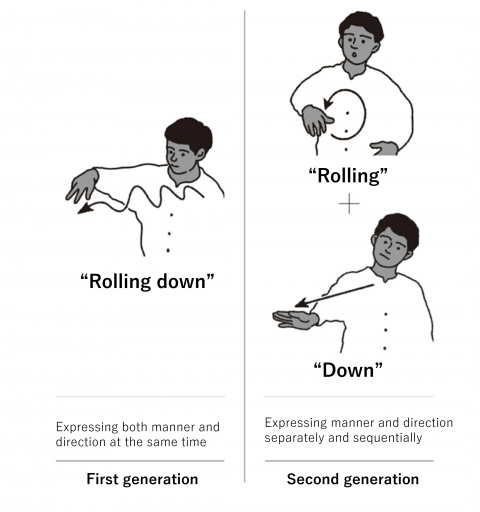
Gesture which at first precisely visualized a concept was later divided into elements and then used in combination. Source: Gengo no Honshitsu: Kotoba wa Doo Umare Shinka Shita ka, p. 150, Fig. 5-2.
A group of highly iconic Japanese onomatopoeic words show traces of changes similar to those undergone by Nicaraguan Sign Language. An example is the difference between “ban” and “batan.” Both express a single impact sound, but while “ban” can be used for a variety of strong impact sounds such as a collision or an explosion, the use of “batan” is usually limited to the sound of a flat object falling or shutting. In fact, the consonant /t/ in “batan” indicates hitting or contact, as in “dotan” (the sound of a heavy object falling), “goton” (the sound of a hard object hitting against something), “boto-boto” (the sound of large drops dripping), and “gotsun” (the sound of a heavy object hitting hard against something). The consonant /t/, which represents one of the subdivided categories of strong impact sounds, has created different meaning from “bashan” (the sound of fluid collisions), “bachan” (the sound of fluid hitting flat object), or “baran” (the sound of a bundle of thin objects unravels). Onomatopoeia are highly iconic but systematic, as mentioned at the beginning.
The last topic to cover in this section is the question of why onomatopoeia differs depending on the language or dialect. First, for the understanding of this topic, guess what animal is represented by all these words: “chako,” “tako,” and “guruu.” Believe it or not, the answer is a cat. “Chako” is a Tohoku region dialect term. In that region, “cha,” a tutting sound used to attract a cat, has been joined with “ko,” a suffix for something adorable, making “chako.” While it remained “chako” on the Yamagata prefecture (Japan Sea) side of the region, on the Miyagi prefecture (Pacific) side, it changed in sound to “tako.” “Guruu” is a dialect term of Kikai Island in Kagoshima Prefecture. It evolved as such from “guru-guru,” the way a cat purrs. Many onomatopoeic words are transcriptions of actual sounds made by objects, but they can be completely different depending on which sounds of the objects are transcribed. Differences in onomatopoeia between languages is also attributed to the phonological system of the individual languages. For example, in English, “brrr” is the transcription of a shiver, while “vrrr” is that of a car engine sound. In contrast, Japanese speakers do not distinguish between [b] and [v], and they may not be able to accurately grasp the difference in nuance.
This book also argues that the cause of these changes lies in our ability to handle metaphors and metonymies. These are only a few examples of the views the book presents from various perspectives. You should definitely pick it up and read it.
● New possibilities of onomatopoeia in cross-disciplinary research
Onomatopoeic words such as “zuki-zuki (throbbing),” “kiri-kiri (splitting),” and “chiku-chiku (tingling)” are useful and familiar expressions you may use when explaining your poor physical condition. For example, a patient may tell the doctor s/he has a “chiku-chiku (tingling)” pain. A report shows that patients feel relieved if the doctor repeats the same onomatopoeic word in agreement, in this example by saying, “I know it’s chiku-chiku.” On the other hand, because of their highly subjective nature, onomatopoeic words that describe physical condition are believed to be difficult to associate with specific symptoms, and doctors find it hard to know how to handle these words. There is room for research into onomatopoeia in medical settings, but much less knowledge has been accumulated so far than you may think.
“It used to be believed that onomatopoeic expressions were vague and varied so much from person to person,” Dr. Akita remarks, “but my study has suggested that inter-personal variability may not be as great as we have expected.”
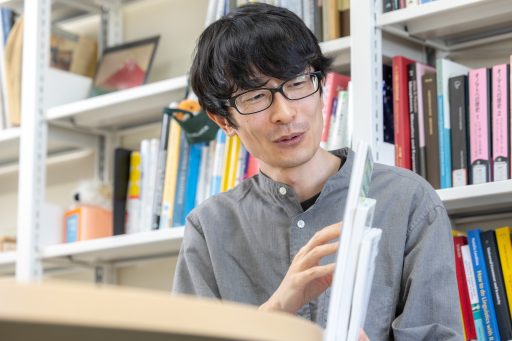
Onomatopoeia, which are nothing new and have always been used casually, are actually part of language in themselves with their own set of meanings and system. Digging into them deeper may enable you to unearth hidden possibilities.
“By verbalizing your sensation, you can organize it, become more aware of it, and share it easily with others,” Dr. Akita points out. “Onomatopoeic words may be difficult to handle at times, but I am sure they have positive aspects and, if used properly, are applicable to medical care.”
(Interview and text by Tatsuro Ayatsuka)
